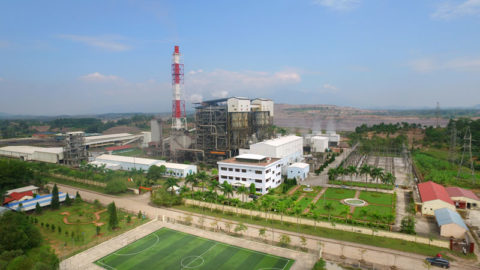
Always paying special attention to the application of science and technology to improve the efficiency of production and business, in recent years, Na Duong Thermal Power Company has made many improvements in some equipment and applied technology new technology, from which bring tangible results.
The highlight is “converting the quail pipe to transport slag from steel materials to wear-resistant porcelain materials”. Talking with the Company’s leaders, it comes from the fact that when using steel bends, it usually only lasts about 2 months to be worn with slag, punctured, interrupting the operation and wasting material costs private, labor to overcome and affect the surrounding environment.
After many times of researching on converting materials and designs from SUS steel, pouring concrete, they have not yet brought significant results. By the time the Company researched the conversion to wear-resistant porcelain material lining the inside of the bend, it has brought practical results, helping the system’s continuous operation time be improved, reducing labor costs for troubleshooting and ensuring environmental safety and occupational safety.
The research and application of “Nalco chemicals to the circulating water system of the factory” also brought many benefits. In fact, the original technology only applied polymers N208 and Javel to circulating water systems. However, after the time of operation, the heat exchangers use circulating water to form scale on the pipe surface, affecting the ability to exchange heat as well as the efficiency and life of the device (screws bottom slag waste, furnace water sample cooler, condenser, cooling tower cooling plate, etc.). When the factory used Nalco chemicals for cooling tower system combined with online water monitoring system to control the quality of cooling tower water (with anti-scale chemicals 3DT104, corrosion resistance 1393, microbicide killers 7342,7330) has helped to limit scale formation, minimize the growth of microorganisms in the system, thereby maintaining the efficiency of heat exchangers as well as performance of the site.
Also to mention is the “Application of automation for conveyor system to discharge slag outside the factory fence”. Previously, Na Duong Thermal Power Company had invested in constructing a conveyor system to discharge slag from 1,500m3 silos out of the factory fence, limiting the ash and slag dispersed during slag transport. However, at that time, the equipment was mainly operated manually, requiring on-site workers to supervise and operate. Starting from the advanced program of automation application on TKV’s production line, the Company’s technical department has researched and implemented the application of automation program for conveyor slag discharge systems out of goods fence factory. Thereby the operation of equipment is more convenient, from the need for workers to supervise on the spot, so far the operation, monitoring can be performed from the live room through control systems, surveillance cameras.
Promoting the achieved results, in order to improve the efficiency of production and business, the Company is continuing to research and deploy the application of technical solutions in the coming time such as: Applying the external desulfurization system furnace (FGD) to improve desulfurization efficiency when coal quality in Na Duong mine is reduced, meeting the required emission requirements; simultaneously improving the efficiency of the boiler as well as the unit.
Besides upgrading the DCS control system with the goals: Update the latest version of the DCS control system software; The hardware in the DCS control system that is at the limit or discontinued support of the manufacturer will continue to be used, when damaged, it can replace the latest product line that ABB has produced since upgrade points; ensure the basic factor is the unit operating stably, reliably and economically; eliminating incidents and potential risks in the system; extend the life and working life of the control system; at the same time improve and improve the working conditions of the team of workers operating the plant in supervising and controlling the Unit in accordance with the plant design parameters, minimizing incidents and reducing operating costs, troubleshooting, etc.
Productivity and Quality Office